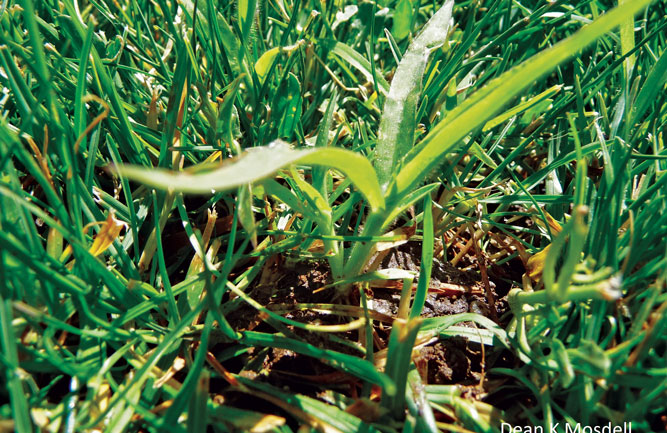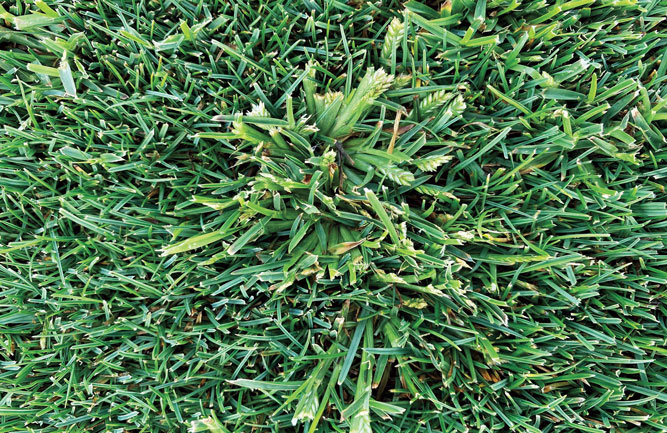Experts share tips on how to manage crabgrass and goosegrass

Crabgrass (Photo: Syngenta)
To successfully manage crabgrass and goosegrass — a pair of problematic weeds in turfgrass systems — a consensus of experts say a preemergent herbicide application is the best approach.
According to Florence Breuillin-Sessoms, Ph.D., a researcher in the department of horticultural science at the University of Minnesota, superintendents can use various herbicides — including Dimension (dithiopyr), Pendulum (pendimethalin), Barricade (prodiamine) and combination products, such as Cavalcade PQ (prodiamine and quinclorac) and Echelon (prodiamine and sulfentrazone) — for preemergent control of crabgrass on either in warm- or cool-season turfgrass.

Goosegrass (Photo: Syngenta)
“Superintendents can also use preemergent herbicides like Bensumec (bensulide) for putting greens and tees,” Breuillin-Sessoms says. “Goosegrass is more difficult to control, though, even as a preemergent. And, as of now, herbicides containing Ronstar (oxadiazon) seem to be the most efficient preemergent control method for established warm- and cool-season turfgrasses.”
To ensure successful spring applications, superintendents must consider the soil temperatures by closely monitoring it between a 0- and 2-inch depth. For instance, crabgrass (smooth and large) will start to germinate after a couple of days when soil temperatures reach 55 degrees F, while goosegrass will germinate after soil temperatures are above 60 degrees F for several days. Superintendents must implement proper preemergent applications exactly when the soil reaches these optimal temperatures.
Superintendents can utilize growing degree days (GDD) as they strive to pinpoint the best times for preemergent herbicide applications. Michigan State University’s GDD tracker offers a GDD32 model, which provides a preemergent application timeline. GDD32 — with a base temperature of 32 degrees F — forecasts when soil temperatures will consistently reach 55 degrees F or higher. A GDD32 between 250 and 500 indicates when superintendents can implement a preemergent herbicide application for crabgrass.
Additionally, superintendents can use GDD50 (with a base temperature of 50 degrees F) to time their preemergent herbicide applications. For crabgrass, a GDD50 above 200 will indicate when a preemergent herbicide application can begin.
“All GDDs accumulate during the growing season,” Breuillin-Sessoms adds. “For that reason, GDD models will always provide superintendents windows of application.”

Aaron Hathaway (Photo: Nufarm)
Nufarm Americas
Aaron Hathaway
Technical services manager
Superintendents can be precise with preemergent herbicide applications, as they’re able to wait closer to crabgrass and goosegrass germination, thereby receiving a longer residual while also potentially reducing breakthrough. For crabgrass, 80 percent of germination will occur when soil temperatures — at 0- to 2-inch depths — are consistently between 60 and 70 degrees F. Goosegrass tends to begin germination a few weeks later than crabgrass. By timing a preemergent herbicide application before crabgrass germination occurs, superintendents can control both. If superintendents can’t apply their application until later in the year — perhaps when crabgrass has already begun to germinate — a product containing dithiopyr is a nice option, as it can provide very early postemergent crabgrass control. However, it’s important to remember that it may not offer goosegrass control.

Ian Rodriguez, Ph.D. (Quali-Pro)
Quali-Pro
Ian Rodriguez
Technical services manager
The name of the game in preemergent use is ensuring applications are on the ground before optimal environmental conditions for weed seed germination. Soil temperatures are typically used to plan these applications. Preemergent herbicide applications need to be applied earlier in more southern locations. Initial crabgrass preemergents should be applied when warming soil temperatures first reach between 52 and 55 degrees F. Dinitroaniline products, such as dithiopyr and prodiamine, are good crabgrass options. Goosegrass seeds begin germinating closer to 60 degrees F — sometimes two to four weeks later than crabgrass. Oxadiazon is highly effective for preventing goosegrass and offers superintendents the additional advantage that it doesn’t hinder root growth of the desirable turf species. Herbicides begin degrading as soon as they are applied, so multiple applications are ideal.

Dean Mosdell (Photo: Syngenta)
Syngenta
Dean Mosdell, Ph.D.
Technical services manager
Preemergent herbicide applications will prevent weed emergence from soil, including the growth and development of newly germinated weed seeds. The site of activity depends on the herbicide mode of action, but the optimum application timing is prior to the germination of weed seeds. Soil temperatures and moisture trigger the germination of weed seeds. Crabgrass seeds will germinate as soil temperatures exceed approximately 58 degrees F for several days, while goosegrass seeds will germinate several weeks later, especially as soil temperatures exceed roughly 62 to 63 degrees F.

Ken Hutto (Photo: FMC)
FMC
Ken Hutto, Ph.D.
Product development manager for herbicides and fungicides
For crabgrass control, the most common active ingredients are products that contain dithiopyr, indaziflam, pendimethalin or prodiamine. On the other hand, for goosegrass control, superintendents will commonly use products containing indaziflam, oxadiazon or prodiamine. Geography and turfgrass type will dictate which active ingredient a superintendent may use. It is important to understand the product label to determine which rate to use and if the desirable turfgrass type is tolerant to the product.

Bret Corbett (Photo: Prime Source)
Prime Source
Bret Corbett
Technical services manager
Crabgrass and goosegrass are true annuals that have become perennial problems in turf systems. These plants germinate in the spring and grow rapidly throughout the year, so the best method for reducing pressure is having healthy turf and soil. However, sometimes the only option is herbicides. The best way to prevent these grassy weeds is through preemergent herbicide applications, as they prevent weeds from developing in the first place. To prevent any growth, superintendents must utilize their applications before the weeds germinate, though.

Gil del Rosario (Photo: Corteva Agriscience)
Corteva Agriscience
Gil del Rosario
Western district leader and market development specialist
When superintendents choose preemergent herbicide applications for crabgrass and goosegrass, it is critical for them to understand the ability to deliver consistent control. Crabgrass begins to germinate in the spring when soil temperatures warm for several days to about 53 to 58 degrees F. Goosegrass, on the other hand, typically germinates when the soil temperatures are 10 degrees warmer. Because of this wide range of weed emergence, some products that target crabgrass fall short of controlling goosegrass, while others used for goosegrass control are unreliable for crabgrass. Turf safety is also critical for selecting the best preemergent herbicide application for target weeds.

Eric Reasor (Photo: PBI-Gordon)
PBI-Gordon
Eric Reasor, Ph.D.
Southeast research scientist
Crabgrass and goosegrass are both summer annual weeds (in most environments) that germinate when soil temperatures increase in the spring. As with any weed in turfgrass, the maintenance of a healthy turfgrass stand is the best management strategy. However, crabgrass and goosegrass are weeds that typically warrant an herbicide application.
Preemergent herbicide applications are the foundation of an herbicide program for managing these weeds. Some examples of herbicides, which are highly effective for crabgrass control, include bensulide, dithiopyr, indaziflam and prodiamine. Meanwhile, three herbicides are particularly effective on goosegrass: indaziflam, oxadiazon and prodiamine. Preemergent herbicide applications inhibit weed seeds from emerging, so they’re the most effective if weeds haven’t emerged.











